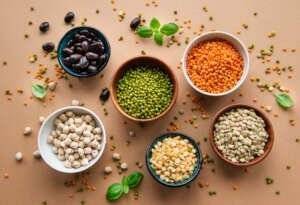Chronic pain in areas like the neck, back, and ankles can severely impact daily life. While medications and physical therapy are often prescribed, incorporating protein-rich nutrition into your pain management plan is an effective strategy. Protein helps with muscle repair, reduces inflammation, and accelerates healing, offering long-term relief.

How Protein Supports Chronic Pain Relief
1. Muscle Repair for Pain Reduction
Chronic pain often results from muscle strain or tension in the neck, back, or ankles. Protein, made up of amino acids, is essential for repairing and rebuilding muscle fibres. By enhancing muscle recovery, protein minimizes discomfort and prevents future injuries.
2. Inflammation Reduction with Protein-Rich Foods
Inflammation is a common factor in chronic pain, particularly in joints and muscles. Certain protein-rich foods, such as those high in omega-3 fatty acids, offer anti-inflammatory benefits.
- Fatty Fish: Salmon and mackerel provide both high-quality protein and omega-3s, helping to reduce inflammation linked to arthritis and musculoskeletal disorders.
3. Faster Healing and Recovery
Protein plays a critical role in tissue regeneration, making it vital for recovering from injuries like sprains or strained muscles. Adequate protein intake accelerates the repair of ligaments, tendons, and cartilage, speeding up recovery and alleviating pain.
4. Enhancing Muscle Health and Joint Stability
Chronic pain often leads to reduced activity, resulting in muscle loss and weakened joints. Protein helps maintain muscle mass, providing better support to the joints and reducing strain on areas like the neck, back, and ankles.
Top Protein Sources for Managing Chronic Pain

Incorporate these high-quality protein options into your diet to support pain relief and recovery:
- Lean Meats: Chicken, turkey, and lean beef are excellent for muscle repair.
- Fatty Fish: Salmon and sardines deliver anti-inflammatory omega-3s and high protein.
- Legumes: Lentils, chickpeas, and beans offer plant-based protein and fibre.
- Dairy Products: Milk, yogurt, and cheese provide protein and calcium for muscle and bone health.
- Plant-Based Options: Tofu, tempeh, quinoa, and edamame are ideal for vegetarians or vegans.
Practical Tips for Incorporating Protein into Pain Management
- Meal Planning: Ensure each meal includes a quality protein source to support muscle health.
- Balance with Other Nutrients: Pair protein with anti-inflammatory foods like leafy greens, nuts, and berries for holistic pain relief.
- Hydration and Recovery: Drink plenty of water to aid nutrient absorption and tissue recovery.
Conclusion
Protein is more than a muscle-building nutrient—it’s a critical ally in managing chronic pain. By aiding muscle repair, reducing inflammation, and accelerating recovery, protein enhances mobility and quality of life. Incorporate protein-rich foods into your daily diet to experience the benefits of improved strength, stability, and long-term pain relief.
For personalized advice, consult with a healthcare professional or dietitian to optimize your protein intake for chronic pain management.
References
- “The Role of Protein in Musculoskeletal Health,” Journal of Clinical Medicine, 2020.
- “Protein and Muscle Health: A Comprehensive Review,” Nutrients, 2019.
- “Protein Supplementation for Recovery and Pain Reduction,” Journal of Sports Science & Medicine, 2018.
- “The Effects of Protein on Inflammation and Recovery,” Clinical Nutrition, 2017.
- “Protein Intake and Muscle Repair in Chronic Pain Management,” American Journal of Clinical Nutrition, 2016.


